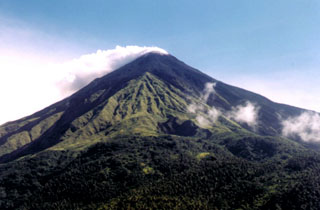Report on Karangetang (Indonesia) — 3 August-9 August 2011
Smithsonian Institution / US Geological Survey
Weekly Volcanic Activity Report, 3 August-9 August 2011
Managing Editor: Sally Sennert.
Please cite this report as:
Global Volcanism Program, 2011. Report on Karangetang (Indonesia) (Sennert, S, ed.). Weekly Volcanic Activity Report, 3 August-9 August 2011. Smithsonian Institution and US Geological Survey.
Karangetang
Indonesia
2.781°N, 125.407°E; summit elev. 1797 m
All times are local (unless otherwise noted)
CVGHM reported that during July and August cloud cover often prevented observations of Karangetang, although white smoke was sometimes observed rising as high as 500 m above the crater. At night incandescence up to 10 m was often observed.
On 8 July a phreatic eruption occurred from the N part of the Main Crater, ejecting material 150 m high. On 24 July and 1 August incandescent material traveled 1,500 m from the Main Crater. Sounds indicating an eruption were heard on 7 August, although fog prevented observations of the crater. Based on recent visual observations and increased seismicity, the Alert Level was raised to 3 (on a scale of 1-4) on 8 August. According to a news article, about 600 people living on the flanks evacuated.
Geological Summary. Karangetang (Api Siau) volcano lies at the northern end of the island of Siau, about 125 km NNE of the NE-most point of Sulawesi. The stratovolcano contains five summit craters along a N-S line. It is one of Indonesia's most active volcanoes, with more than 40 eruptions recorded since 1675 and many additional small eruptions that were not documented (Neumann van Padang, 1951). Twentieth-century eruptions have included frequent explosive activity sometimes accompanied by pyroclastic flows and lahars. Lava dome growth has occurred in the summit craters; collapse of lava flow fronts have produced pyroclastic flows.
Sources: Herald Sun, Pusat Vulkanologi dan Mitigasi Bencana Geologi (PVMBG, also known as CVGHM)

